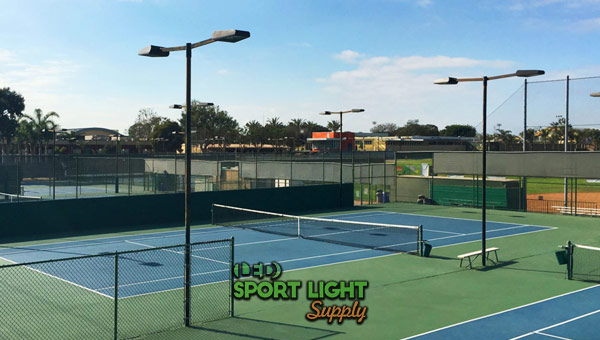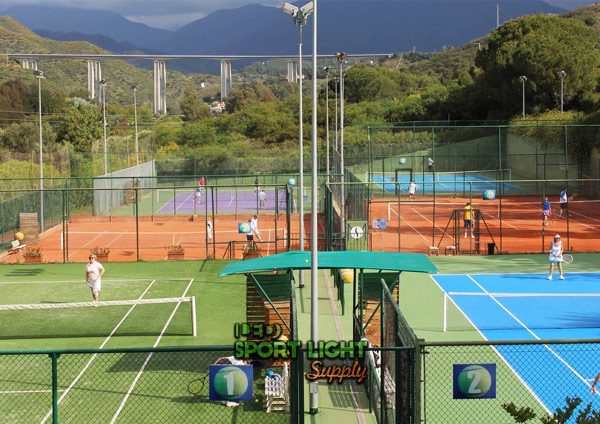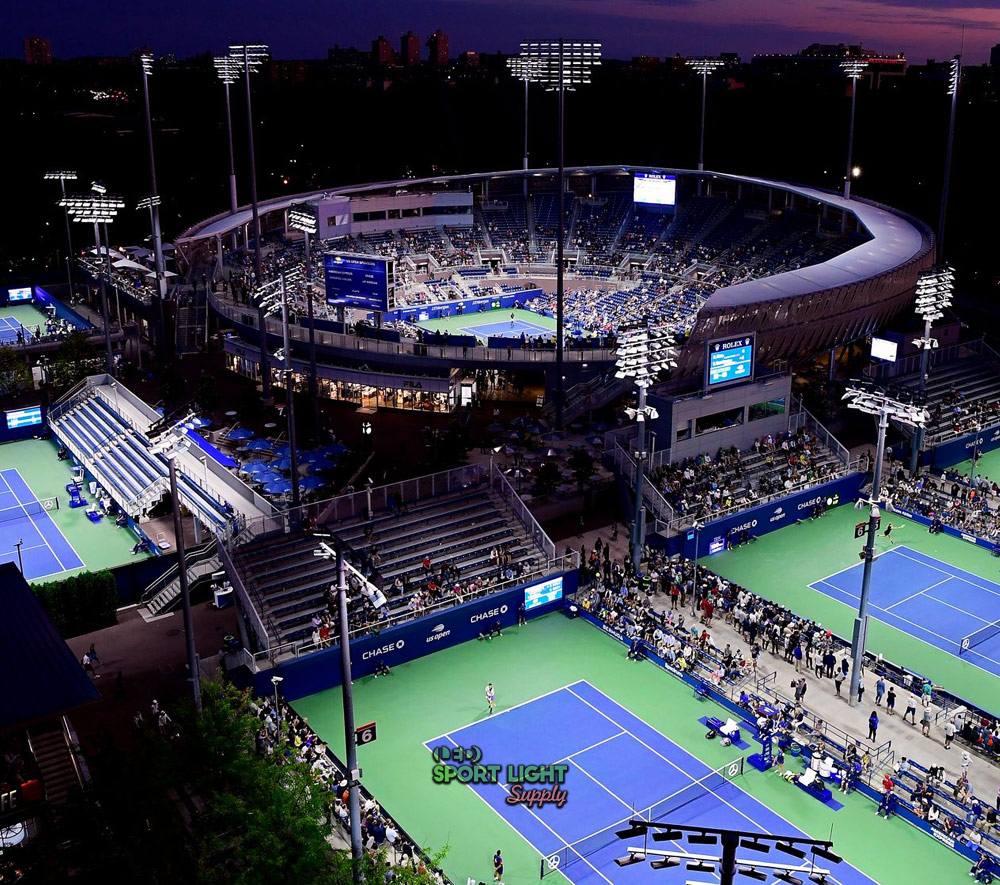The height of light poles is a crucial consideration in the construction of new tennis courts. If you’re wondering about the optimal height for tennis court light poles, you’re in the right place. In this guide, we will cover the standard and most commonly used pole heights, as well as address the issues associated with incorrect pole heights.
Table of Contents
ToggleTennis Court Lighting Pole Height
Selecting the appropriate height for tennis court light poles is essential, as it directly impacts lighting uniformity, shadow, and brightness. The optimal pole height can vary depending on the level of play and specific lighting requirements. Here’s a closer look at the different pole heights used for various types of tennis courts:

Recreational and Residential Tennis Courts
For recreational or residential tennis courts, the typical light pole height ranges from 6 to 8 meters (20 to 26 feet). For budget-conscious projects, using 4 poles at 8 meters or 6 poles at 6 meters can provide satisfactory lighting results.
If the poles are only 6 meters high, at least 2 lamps per pole are recommended to ensure better lighting uniformity. This setup helps to prevent bright spots from forming in the service boxes, which can affect gameplay.

Commercial Tennis Courts
In commercial settings, such as tennis clubs or community courts, the pole height generally ranges from 8 to 12 meters (26 to 39 feet). Taller poles help minimize shadows cast by players, racquets, and the net, offering improved visibility.
Common configurations include 6-pole, 8-pole (for single courts), and 9-pole (for adjoining courts) setups. Each pole typically supports 1 to 2 lamps, which are sometimes positioned perpendicularly to enhance coverage and uniformity.
It’s important to consider light spill in commercial designs. Higher pole heights can lead to light escaping the court and affecting the surrounding area. A comprehensive lighting design is necessary to manage light spill effectively. For detailed guidance, you may contact our lighting engineer for a free consultation and DIALux photometric report.
Professional Tennis Stadiums

For professional tennis stadiums, such as those hosting international tournaments like the ATP Tour, WTA Tour, and Wimbledon, the lighting standards are exceptionally high. The pole height in these venues typically ranges from 15 to 20 meters (50 to 66 feet).
An interesting requirement from the ATP specifies that light poles for ATP tennis courts should be at least 12 meters (40 feet) high. This height improves lighting uniformity and reduces glare. In some high-profile cases, clients have opted for even taller poles, up to 22 meters (72 feet), to meet Class I lighting standards for top-tier tennis events.
Tennis Court Lighting Pole Height Issues
Understanding the standard pole heights for tennis court lighting—6 to 8 meters for recreational courts, 8 to 12 meters for commercial courts, and above 15 meters for international tournament venues—helps in making informed decisions. However, both excessively tall and short poles can present problems. Let’s explore these issues and their solutions.
Problems with Excessively Tall Tennis Court Light Poles
When light poles are too tall, several issues can arise:
Light Spill
One of the challenges associated with using taller poles is increased light spill. As the height of the poles increases, the light fixtures are positioned higher above the tennis court, which can result in a larger area of light dispersion beyond the intended playing surface. This additional light can affect the surrounding environment, potentially leading to light pollution that disrupts nearby residential areas or natural habitats.
To manage light spill effectively, it is crucial to use lighting fixtures designed with smaller beam angles. These fixtures direct light more precisely onto the court, minimizing the amount of light that escapes into the surrounding area. Additionally, if there are no nearby trees, walls, or other natural barriers that can help block or absorb excess light, opting for a pole height of around 6 to 7 meters can help in reducing light spill. This height strikes a balance between adequate illumination on the court and limited impact on the surrounding environment.
Increased Light Loss
Taller poles can also lead to increased light loss, as they often necessitate the installation of more luminaires to cover the same area effectively. When poles are positioned higher, more fixtures are required to ensure that the entire court is uniformly illuminated. This results in higher operational costs due to the increased number of luminaires needed and the associated energy consumption.
To mitigate these costs, consider using shorter poles paired with energy-efficient LED lights. LEDs are designed to provide high levels of illumination while consuming less power compared to traditional lighting sources. By combining shorter poles with LED technology, you can achieve the necessary lighting levels on the court while keeping energy costs and maintenance requirements lower. This approach not only helps in reducing operational expenses but also supports more sustainable and cost-effective lighting solutions for tennis courts.
Problems with Insufficiently Short Tennis Court Light Poles
Shorter light poles, particularly those lower than 5 meters, can also create several challenges:
Bright Spots
When light poles are too short, typically below 5 meters, it can lead to a range of lighting problems. One significant issue is the formation of bright spots near the poles. This occurs because the distance between the lighting fixtures and the tennis court surface is reduced, meaning the light beam has less space to spread out and diffuse before it hits the court. As a result, the light is concentrated in specific areas, creating uneven lighting with pronounced bright spots.
These spots can be particularly disruptive during play, as they create visual inconsistencies that can impact the player’s ability to track the ball and judge distances accurately. Ensuring an appropriate pole height helps in achieving a more uniform light distribution, reducing the occurrence of such bright spots and enhancing the overall visibility on the court.
Glare
Another issue with short poles is the potential for glare. Shorter poles place the light fixtures closer to the court, which can cause direct light to shine into players’ eyes, especially when they look up to spot the ball or make a shot. This direct glare can be quite uncomfortable and may strain players’ eyes, leading to reduced performance and increased difficulty in maintaining focus.
Inadequate pole height can exacerbate this problem, making it crucial to select poles of sufficient height to position the fixtures at an angle that minimizes direct light exposure to players. By optimizing pole height, you can reduce glare and ensure that the lighting is both effective and comfortable for players, ultimately supporting a better playing experience.
When planning the lighting layout for a tennis court, it is crucial to find a balance in pole height to avoid these problems. For personalized advice and solutions, please contact our lighting engineer. We offer free lighting design services for tennis courts and other sports fields.
Conclusion
The height of light poles is essential for effective tennis court lighting, impacting visibility, shadow, and uniformity. Recreational courts typically use poles ranging from 6 to 8 meters, while commercial and professional courts require taller poles—8 to 12 meters for commercial and 15 meters or more for professional venues.
Choosing the correct pole height helps address common issues such as light spill, glare, and bright spots. Proper design and the use of energy-efficient LEDs can mitigate these problems and enhance the overall playing experience. For expert guidance and personalized lighting solutions, contact our lighting engineer for a free consultation.
